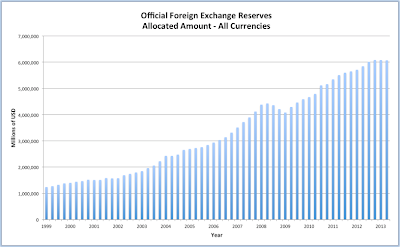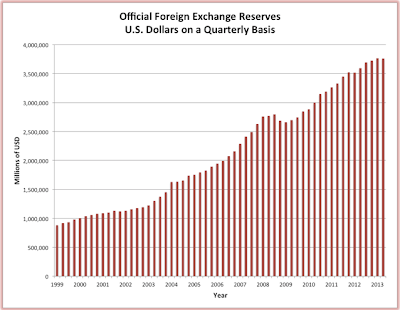Now that another brush with "debt death" has passed, the world's economy is breathing a sigh of relief. With the United States dollar being the world's foremost currency, what happens in America definitely doesn't stay in America. That's the danger of having a fiat currency as a reserve!
That said, how much of the world's total foreign exchange reserves is held in U.S. dollars and how has that changed with time? Fortunately for us, the IMF keeps track of this data in its Currency Composition of Official Foreign Exchange Reserves (COFER) database. The currencies that it keeps track of are the U.S. dollar, the Canadian dollar, the pound stirling, the Japanese yen, the Swiss franc, the Euro and the Australian dollar. The IMF does not release data for the reserve composition of individual countries since that is considered confidential.
Foreign exchange reserves include foreign banknotes, bank deposits, short and long-term government securities and treasury bills but do not include reserves held by the country of issue (i.e. the euro assets of the ECB are not included nor are the U.S. dollar assets held by the Federal Reserve).
Let's open with a graph showing the growth in the total allocated foreign exchange reserves since 1999:
Total allocated foreign reserves grew from $1.035 trillion at the beginning of 1999 to $6.070 trillion in the second quarter of 2013, an increase of 486 percent.
Now, let's look at a graph showing the growth in the number of United States dollars held in foreign exchange reserves since 1999:
Total U.S. dollars held rose from $882.3 billion at the beginning of 1999 to $3.706 trillion in the second quarter of 2013, an increase of 320 percent. Of the total United States dollars held in foreign reserves, $3.669 trillion or 97.6 percent are held by the world's advanced economies. The remaining relatively insignificant amount is held by the world's emerging economies.
Notice that the increase in total foreign reserves is substantially higher than the increase in U.S. dollar holdings in those reserves?
Lastly, lets look at how the percentage of total allocated foreign reserves held in U.S. dollars has changed since 1999 as shown on this line graph:
Back in 1999 and 2001, between 71 and 73 percent of foreign reserves around the world were held in United States dollars. This level began to drop in 2002 and has steadily dropped to its current level of 61.9 percent. While the total value of U.S. dollars held in foreign reserves has risen by 320 percent since 1999, the proportion of those reserves has dropped by 15 percent.
Of the total United States dollars held in foreign reserves, $3.669 trillion or 97.6 percent are held by the world's advanced economies. The remaining relatively insignificant amount is held by the world's emerging economies.
While the United States dollar is viewed as being "too big to fail", this data shows us that the importance of the USD as a reserve currency has declined to a rather substantial degree. With the recent shenanigans in Washington, perhaps the world is becoming a bit wiser when it comes to relying on a single fiat currency as its primary reserve.
Click HERE to read more of Glen Asher's columns
You can publish this article on your website as long as you provide a link back to this page.




Be the first to comment